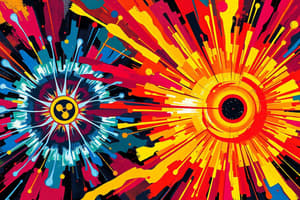Podcast
Questions and Answers
What is the role of the first ribosomal subunit in translation?
What is the role of the first ribosomal subunit in translation?
- It carries the next amino acid in the sequence.
- It binds to the initiator tRNA at the start codon. (correct)
- It binds to the mRNA at the stop codon.
- It releases the polypeptide chain from the ribosome.
How is the polypeptide chain elongated during translation?
How is the polypeptide chain elongated during translation?
- The initiator tRNA elongates the polypeptide chain.
- Each ribosomal subunit adds a new amino acid.
- The replication process elongates the polypeptide chain.
- Each transfer RNA adds its amino acid to the chain. (correct)
Why is replication and translation crucial for living organisms?
Why is replication and translation crucial for living organisms?
- They are not crucial for living organisms.
- They aid in cell division.
- They produce energy for the cells.
- They help in growth and development by producing new proteins. (correct)
What is the role of polymerase in nuclear acid replication?
What is the role of polymerase in nuclear acid replication?
Where does translation take place?
Where does translation take place?
What is the function of transfer RNA (tRNA) in translation?
What is the function of transfer RNA (tRNA) in translation?
What initiates the process of translation?
What initiates the process of translation?
Study Notes
- Newsbite: Discussing nuclear acid replication and translation.
- Nuclear acid, or DNA, is made up of a long chain of nucleotides. A single nucleus contains a limited number of genetic material sets that determine development of an organism, be it a cat or a human.
- Replication and translation are the mechanisms through which nuclear acid is read and proteins are produced within the cell.
- Chromosomes, long chains of nucleotides composed of millions of base pairs, contain most of the genetic material in an organism. Certain specific sections of chromosomes, called genes, contain the information for producing specific proteins.
- Replication occurs when enzymes within the nuclear acid use one strand of DNA as a template to create a complementary strand. This is facilitated by an enzyme called polymerase, which binds to the template strand and moves along it, creating a new complementary strand.
- Translation takes place within the ribosome, where messenger RNA (mRNA) acts as a template for the synthesis of a specific protein. Each set of three nucleotides in the mRNA is called a codon, and it codes for a specific amino acid.
- Transfer RNA (tRNA) acts as a carrier for specific amino acids, bringing them to the ribosome where they are added to the growing polypeptide chain.
- Initiation of translation begins with the binding of the initiator tRNA, which carries the starting amino acid, to the ribosome. The first ribosomal subunit then binds, and the first transfer RNA carrying the starting amino acid forms a complex with the mRNA and the initiator tRNA at the start codon.
- The next transfer RNA carrying the next amino acid in the sequence binds to the ribosome, and the growing polypeptide chain is elongated as each transfer RNA adds its amino acid to the chain.
- Once all the amino acids in the sequence have been added, the polypeptide chain is released from the ribosome, and the initiation complex dissociates.
- The process of replication and translation is crucial for the growth and development of all living organisms, from bacteria to humans.
- Replication and translation are complex processes that involve many enzymes and RNA molecules working together in a precise and intricate manner to produce new proteins from the genetic information contained within the nuclear acid.
Studying That Suits You
Use AI to generate personalized quizzes and flashcards to suit your learning preferences.
Description
Test your knowledge on the processes of nuclear acid replication and translation, which are essential for reading DNA and producing proteins within cells. Learn about enzymes, RNA molecules, codons, and amino acids involved in these intricate mechanisms.




